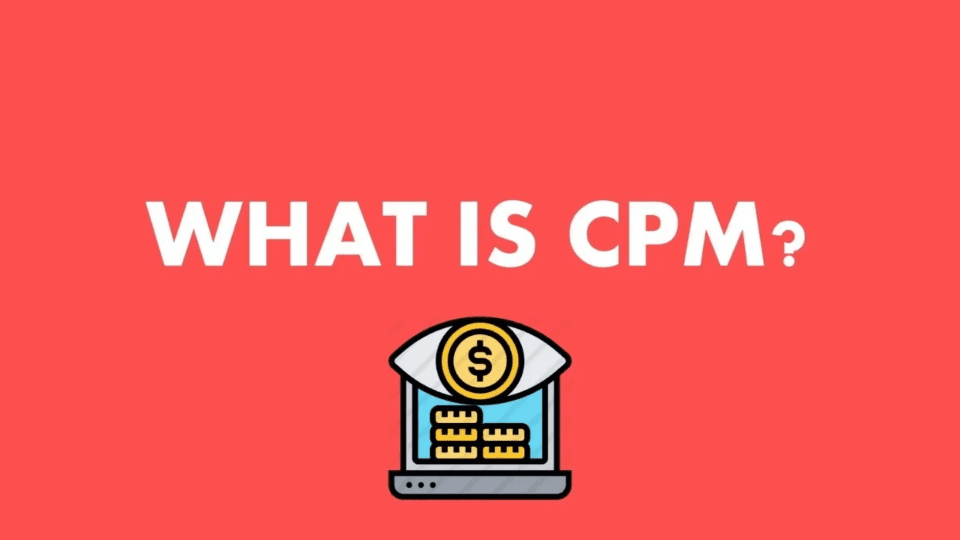CPM is a familiar term in the advertising field, especially when it comes to display advertising campaigns. Understanding what CPM is and how it works can help businesses optimize costs and reach target customers effectively, especially when advertising online. Join MarkKnow to learn more about CPM, its benefits and how to use it most optimally!
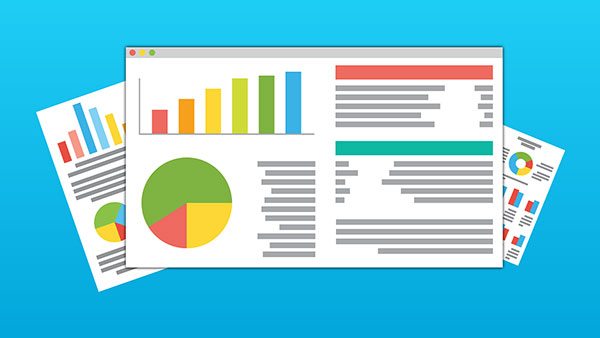
What is CPM?
CPM is an abbreviation for the English phrase “Cost Per 1000 Impressions” or ‘Cost Per Mille”. Simply put, this is the cost paid for 1000 times the ad is displayed on Google. This cost is not fixed but depends on the bid accepted to pay for 1000 times the ad appears in locations that are easy to attract customers.
CPM is one of the most popular pricing methods for Display Ads, Video Ads on digital media platforms such as Google, Facebook, YouTube. If a business has a reasonable CPM strategy, they can better control advertising costs, while optimizing the reach of potential customers.
According to Marketing experts, CPM is an effective top-of-funnel strategy. It depends on many different factors such as geographic location, device, ad size, etc. Brands need to research carefully to optimize effectiveness in practice.
To illustrate how CPM works, consider the following example:
Suppose a Fashion Company wants to advertise their new collection on a popular news website. This website offers a CPM of $5/1000 impressions.
- If a company’s ad is displayed 10,000 times, they will pay: (10,000 / 1000) x 5 = 50 USD.
- If the ad is displayed 50,000 times, the cost will be: (50,000 / 1000) x 5 = 250 USD.
In this case, regardless of how many people actually click on the ad or buy the product, the company still only pays based on the number of times the ad is displayed.
The Role of CPM in Advertising
Join MarkKnow to analyze in detail the main role of CPM in the advertising field below:
Measuring Performance
CPM plays an important role in measuring the effectiveness of advertising campaigns. With CPM, advertisers can accurately track the number of times their ads are displayed, thereby easily assessing whether the campaign is achieving its goal of reaching the target users. In the Vietnamese market, where businesses are increasingly focusing on online advertising, CPM provides an important measure to determine the impact of advertising.
Assessment of Accessibility
CPM is a powerful tool for measuring the reach of an advertising campaign. By determining the number of times an ad is shown to users, businesses can understand the reach of their advertising message. This is especially useful for branding campaigns, where the goal is not immediate sales, but creating awareness and engaging with consumers. In an increasingly digital media environment, the ability to reach a wide audience through CPM is a big advantage.
Comparison With Other Payment Methods
Compared to other payment methods such as CPC (Cost Per Click) or CPA (Cost Per Action), CPM has its own advantages and disadvantages. CPC only charges when users click on the ad, while CPA requires users to perform a specific action (e.g., sign up, purchase). This makes CPM a suitable choice for advertising campaigns that aim to increase brand awareness, rather than drive specific actions from customers.
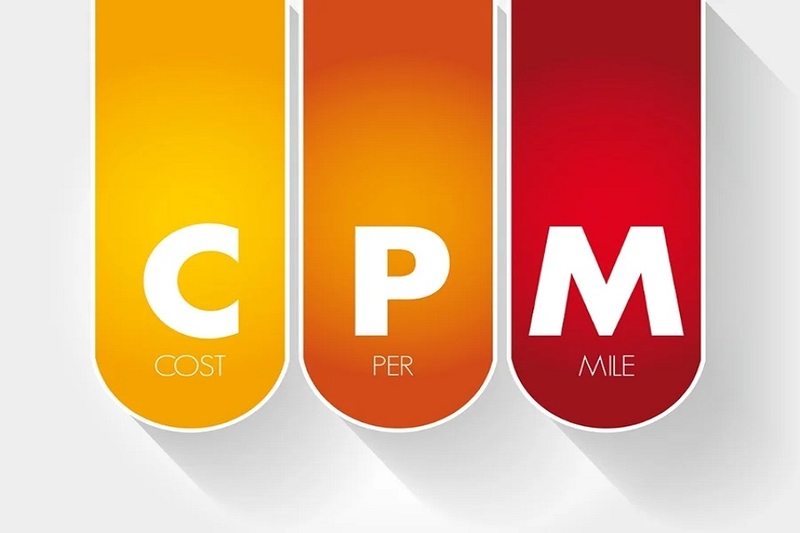
Advantages and Disadvantages of CPM
To have a comprehensive view of CPM and its application in the Vietnamese advertising market, we need to carefully analyze both the advantages and disadvantages of this method.
Advantages
- Easy to Use, Fast Efficiency: One of the biggest advantages of CPM is the simplicity in installation and management. Advertisers only need to choose a budget, set up a campaign, and do not need to track each click or interaction. This is the reason why many businesses, especially startups and small and medium enterprises (SMEs), often prioritize choosing CPM in the early stages of brand building.
- Cost Optimization: CPM costs less than CPC, especially for businesses that already have a certain level of brand recognition. Instead of paying for each click, advertisers only have to pay for every 1,000 impressions, saving costs when reaching a large number of users. If a brand already has a stable number of users accessing the website, CPM will be a cost-effective option.
- Generate Passive Revenue: For websites with high traffic, placing banner ads on the CPM model can generate passive revenue. We often see this on electronic newspapers and blogs with a stable number of viewers. CPM advertising helps these websites make money without requiring users to click on the ads.
Disadvantages
- Not effective for websites with unstable traffic: CPM depends on real visitors to be effective, so if the website does not have stable traffic, this model may not be the best solution. If a website is just starting out and does not have many users yet, spending money on CPM advertising may not bring the desired return.
- High competition with big brands: Another disadvantage of CPM is the high level of competition, especially with big brands that already have a reputation in the market. Small brands may have difficulty attracting customers’ attention when competing with large advertising campaigns. This increases costs and reduces the effectiveness of CPM advertising campaigns for small businesses.
- Costly if not attracting target customers: When CPM ads appear but do not attract customers’ attention, the cost per impression will still be calculated, leading to a situation where businesses have to spend without getting the expected value. Especially in the digital advertising environment, relying only on display without optimizing for target users can cause wasted budget.
CPM Calculation Formula
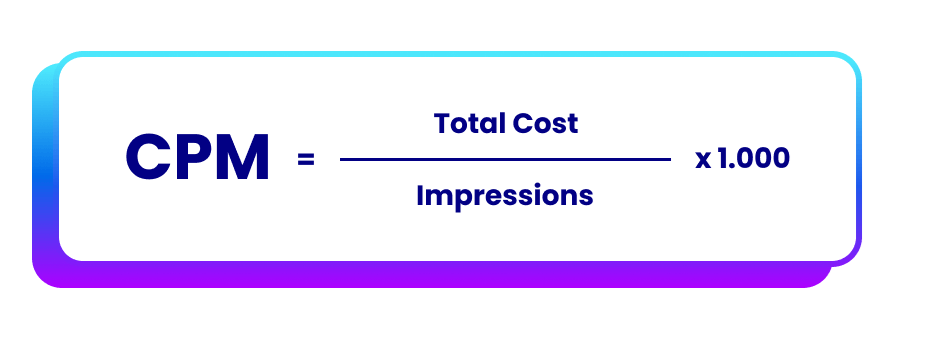
To understand what CPM is in more depth, you need to understand its formula. The formula is very simple:
Specific example: Suppose you are running a Facebook advertising campaign with a total cost of $100 and your ad is displayed 500,000 times.
This formula helps businesses easily control the costs of display advertising campaigns, thereby assessing whether they are overspending or optimizing their budget. Especially when online advertising costs can vary based on seasonality and campaign goals, this formula is an indispensable tool for effective budget management.
What is the Average CPM Rate?

Average CPM rates can vary depending on many factors such as advertising platform, industry, and geographic region. Globally, CPMs typically range from $1 to $10 per 1,000 impressions. However, in Vietnam, CPM rates are often lower because advertising costs here are still relatively cheap compared to developed markets.
The price of running Facebook ads for CPM can range from 1 to 5 USD depending on the target audience and advertising content. Meanwhile, on the Google Display Network, CPM can be a bit higher, ranging from 2 to 10 USD. This depends on the advertising goals of the business and the industry in which they operate.
Understanding the average CPM rate helps businesses adjust their budgets and advertising goals, ensuring that the costs they spend are reasonable and effective.
How to Determine If CPM is Good Enough?
To know if the CPM you are paying is reasonable or not, it is not only based on the CPM number but also needs to be evaluated based on many factors. Determining whether the CPM is good enough or not requires you to consider from many angles, from the business industry to advertising effectiveness and return on investment (ROI).
Comparison With Industry CPM
An effective way to determine whether your CPM is reasonable or not is to compare it with the average CPM of the industry you are operating in. For example, in the online fashion industry, the CPM may be between 2 – 5 USD, but in the technology or finance industry, the CPM may be higher, up to 10 USD. Industries such as tourism and technology often have higher CPMs due to the level of competition and high demand for product promotion.
When comparing your CPM to industry averages, keep in mind that a CPM that’s too low could mean your ads aren’t being shown to your target audience. Conversely, a CPM that’s too high could mean you’re wasting your budget without getting the results you want.
Advertising Effectiveness
CPM is only one part of the overall picture of how well an ad campaign is performing. To determine whether your CPM is good enough, look at the effectiveness of your ad – that is, the level of engagement and actual results your ad is delivering. For example, if your CPM is 2 USD but your ad is getting a lot of clicks and engagement, that’s a good sign that your CPM is working.
Consider other metrics like CTR (Click-Through Rate) – the percentage of people who click on your ad after seeing it. If your CPM is high but your CTR is low, this may indicate that your ad is not optimized for the right audience or that your content is not engaging. Conversely, a moderate CPM coupled with a high CTR indicates that your campaign is on track.
Based on ROI (Return On Investment)
Ultimately, the most important factor in determining whether a CPM is effective or not is based on ROI (return on investment). A CPM can be low, but if it does not bring in revenue or clear results, it is still an ineffective investment. ROI helps you evaluate the overall effectiveness of an advertising campaign by comparing the cost and the profit.
For example, if you spend 500 USD on a CPM campaign and get 5000 USD in revenue, your ROI is very high, showing that CPM is working well. However, if you spend the same amount of money but do not bring in revenue, quality visits, it may be time to adjust the campaign, look for another payment method that is more effective.
How to Use CPM Most Effectively
To optimize your CPM advertising strategy, you need to follow some basic principles, from defining goals to optimizing your budget and tracking results. Let’s analyze how to use CPM most effectively for your advertising campaign!
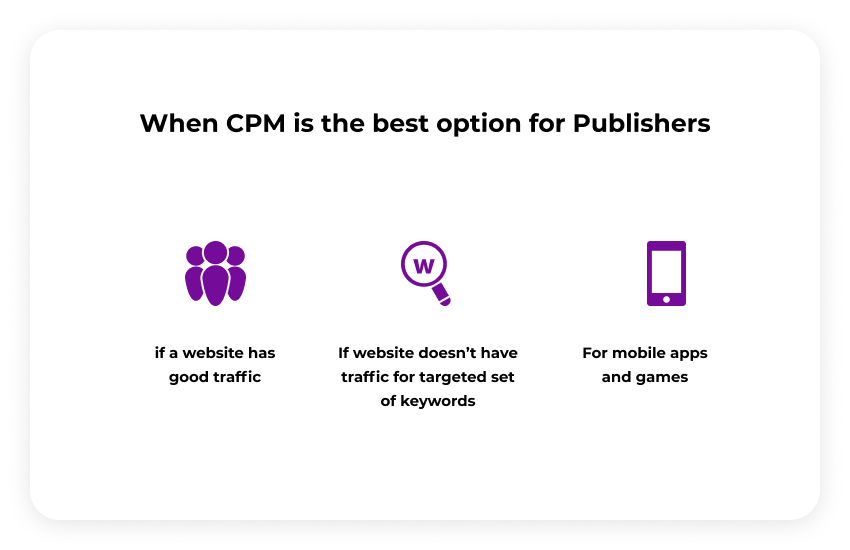
Aim Right
One of the best ways to optimize your CPM is to make sure your ads are reaching the right audience. This not only saves you money, but also increases the effectiveness of your marketing campaigns. Use analytics tools to understand your audience: who they are, where they are, what their interests are? When you target the right potential customers, every ad impression counts. This helps you improve your engagement rate, while reducing your CPM costs, increasing your return on advertising.
Determine the Appropriate Budget
Setting an appropriate advertising budget helps you control your costs appropriately. Assess your finances and determine how much you are willing to invest in advertising based on your campaign goals. Setting a budget that is too high can result in a wasted campaign, while a budget that is too low can result in a campaign that is not effective. Balance your budget based on your campaign goals, predicted conversion rates, and the value each impression can bring to you.
Campaign Planning
Detailed planning for your CPM campaign is key to controlling every aspect, from cost to effectiveness. You need to define specific goals: increase brand awareness, attract new customers, or increase sales? Then, divide the campaign into stages for easy monitoring and adjustment when necessary. This helps you not only optimize CPM but also maintain consistency and effectiveness throughout the advertising implementation process.
Optimizing Related Factors
An effective CPM campaign depends heavily on optimizing elements such as content, images, and advertising messages. The content must be attractive and attract attention immediately, while images and videos need to reflect the message and brand values. Don’t forget to regularly A/B test to determine which version of the ad performs best. When you optimize all the relevant elements, the performance of the ad will increase, thereby naturally reducing the CPM.
Deployment on New Platform
When you feel that CPM on a particular platform is no longer as effective as before, boldly experiment on new platforms. Channels like TikTok, YouTube, or online newspapers can bring good results with lower CPM. Each platform has a different customer base and interaction style, so deploying a campaign on a new platform not only expands reach but also helps optimize costs. Sometimes, a new platform can bring unexpected results that you never thought of.
Integration with Other Tools
Using CPM in combination with other forms of advertising such as CPC, CPA or CPL will help you have a comprehensive view of campaign effectiveness. Each advertising model has its own advantages and disadvantages, when combined, you can get the best from each model. You can use CPM to reach more customers, then use CPC or CPA to convert these customers into actual buyers. This combination not only helps you optimize costs but also ensures that every aspect of the campaign is managed effectively.
Performance Monitoring
No campaign is successful without constant monitoring. Tracking metrics like impressions, click-through rates, and conversion rates will help you understand whether your CPM is actually effective. If you find that your CPM is too high and not delivering the results you want, you can adjust your content and change your strategy. By tracking performance in real time, you will always be aware of the state of your campaign and can react promptly to improve results.
Compare CPM and CPC Advertising
When choosing between CPM and CPC, you need to understand the difference between the two models to optimize your advertising campaign.
| Criteria | CPM (Cost Per Mille) | CPC (Cost Per Click) |
| Define | CPM is the cost of paying for 1000 ads displayed on Google to potential customers. | CPC is a form of advertising that charges based on user clicks and is only charged when a customer clicks on the ad. |
| Target audience | Suitable for brands with high recognition that want to expand their reach. | Suitable for campaigns that focus on specific actions from users. |
| Effective | Suitable for large brand promotion campaigns | Suitable for sales campaigns, direct interaction |
| Budget Control | Easy to manage budgets at scale, but no guarantee of engagement | Pay only when someone clicks on your ad |
| Performance Analysis | Difficulty in measuring conversion effectiveness directly from advertising. | Easily track and analyze CTR and conversion rates. |
| Ad run time | Suitable for long term branding campaigns. | Suitable for short term campaigns or special promotions. |
| Advantage |
|
|
| Disadvantages |
|
|
| Usage trends in Vietnam |
|
|
With CPM, you can reach a large audience at a lower cost than CPC, but there is no guarantee that they will engage or take action. With CPC, on the other hand, you pay each time a customer is actually interested in your ad, but costs can be higher if not managed carefully.
The article provides information to help you answer the question “What is CPM ? “ , at the same time grasp the advantages and disadvantages and distinguish in detail from the CPC advertising form. Each form has its own benefits and limitations. To implement effectively, the most important thing is to spend time researching and accurately measuring actual data. Don’t forget to share the article, follow us so you don’t miss the next useful information. Wish the brands success!
Frequently Asked Questions
Is Facebook Advertising Service Worth Using?
Facebook advertising service is very useful if you lack time and experience, helps optimize campaigns and saves effort.
How Can Facebook Advertising Costs Be Controlled?
You can control the cost of running Facebook ads by setting a daily budget, according to the specific campaign.
What is the effective way to run Facebook ads for beginners?
The way to run effective Facebook ads is to focus on the target audience, optimize ad content, and monitor results regularly.
Does CPM Help Increase Sales?
CPM helps increase brand awareness, but to increase sales, you should combine it with other payment models like CPC or CPA.
Comment Policy: We truly value your comments and appreciate the time you take to share your thoughts and feedback with us.
Note: Comments that are identified as spam or purely promotional will be removed.
To enhance your commenting experience, consider creating a Gravatar account. By adding an avatar and using the same e-mail here, your comments will feature a unique and recognizable avatar, making it easier for other members to identify you.
Please use a valid e-mail address so you can receive notifications when your comments receive replies.
